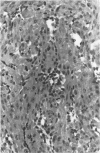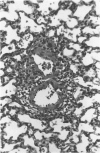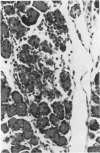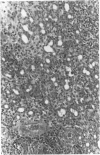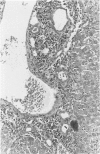Abstract
Null-mutant (knockout) mice were obtained through disruption of the sixth exon of the endogenous transforming growth factor-beta 1 allele in murine embryonic stem cells via homologous recombination. Mice lacking transforming growth factor-beta 1 (mutants) were born grossly indistinguishable from wild-type littermates. With time, mutant mice exhibited a wasting phenotype that manifested itself in severe weight loss and dishevelled appearance (between 15 and 36 days of age). Examination of these moribund mice histologically revealed that transforming growth factor-beta 1-deficient mice exhibit a moderate to severe, multifocal, organ-dependent, mixed inflammatory cell response adversely affecting the heart, stomach, diaphragm, liver, lung, salivary gland, and pancreas. Because of the known multifunctional nature of transforming growth factor-beta 1 on the control of growth and differentiation of many different cell types, it is important to determine the degree to which the inflammatory response interacts with or masks other deficiencies that are present. To this end, we examined the extent and nature of the inflammatory lesions in different ages of neonatal knockout mice (5, 7, 10, and 14 days of age) and older moribund mice (> 15 days of age) and compared them with the histology seen in wild-type normal animals. Mild inflammatory infiltrates were first observed in 5-day mutant mice in the heart, by day 7 in the lung, salivary gland, and pancreas, and by day 14 inflammatory lesions were found in almost all organs examined. Moderate to severe inflammation was not present until the mice were 10 to 14 days old. In the older animals, there was a slight increase in the severity of the inflammatory lesions as the mice aged.
Full text
PDF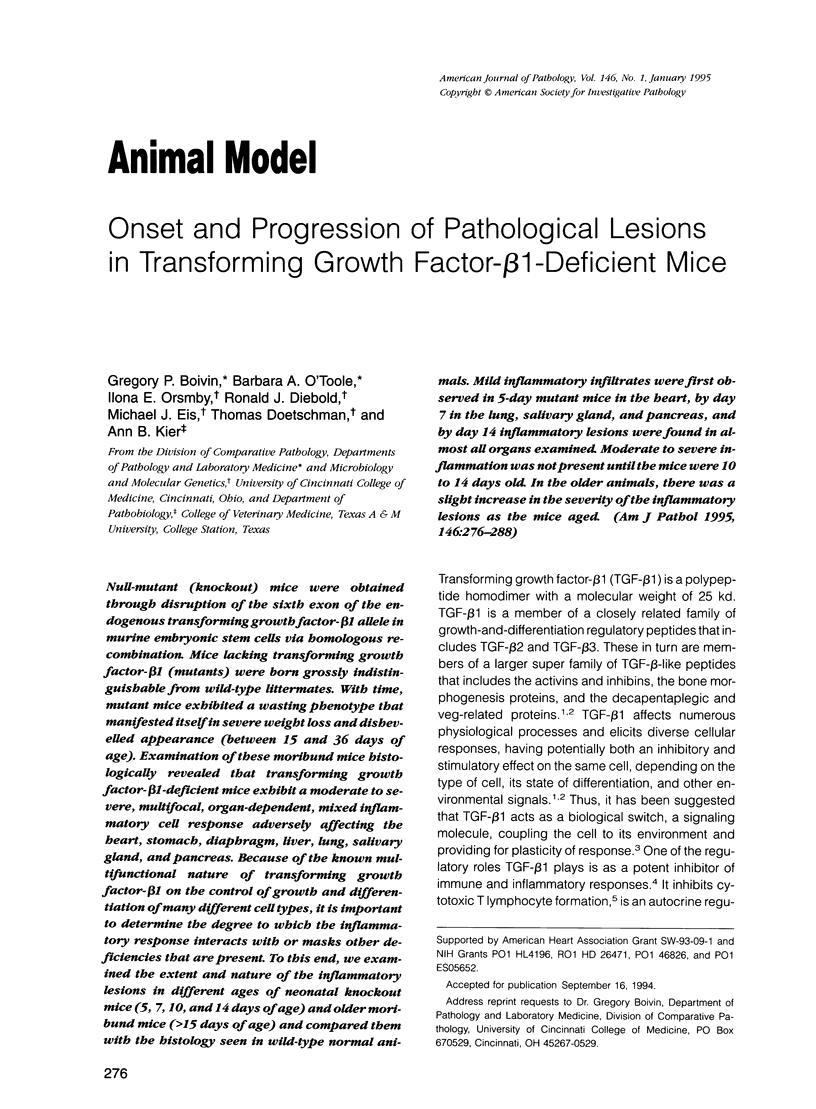
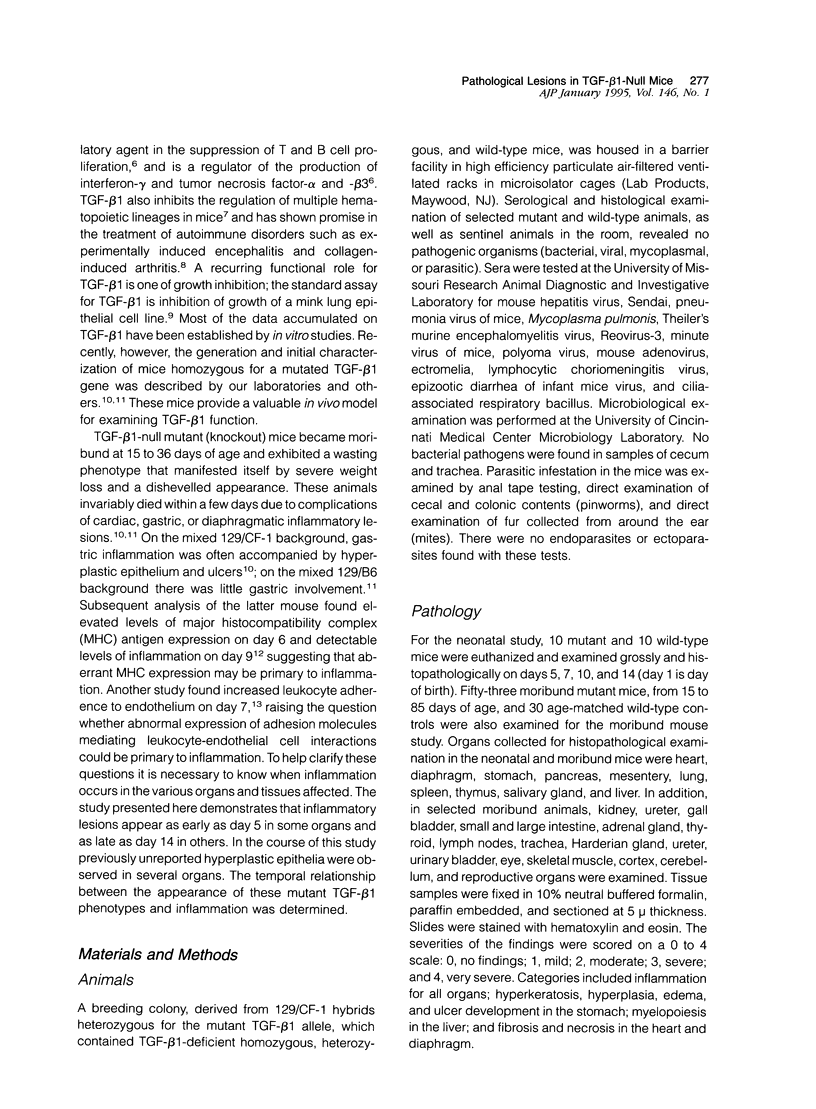
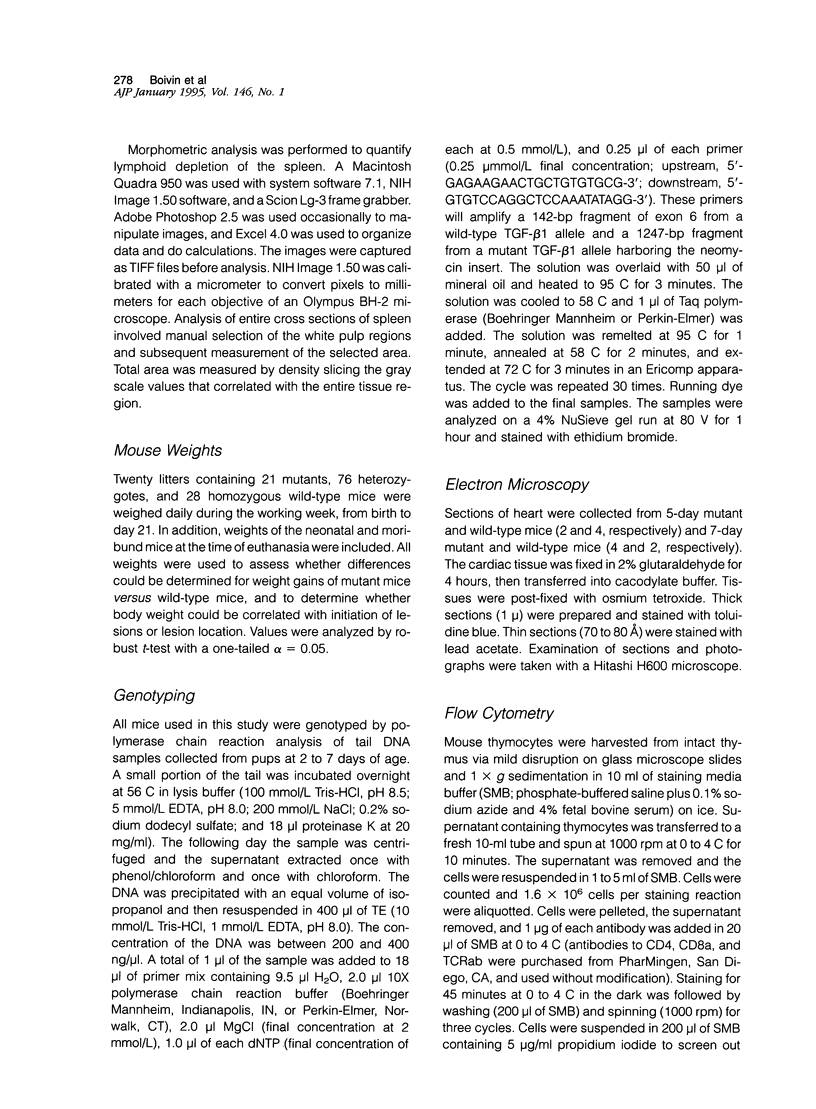
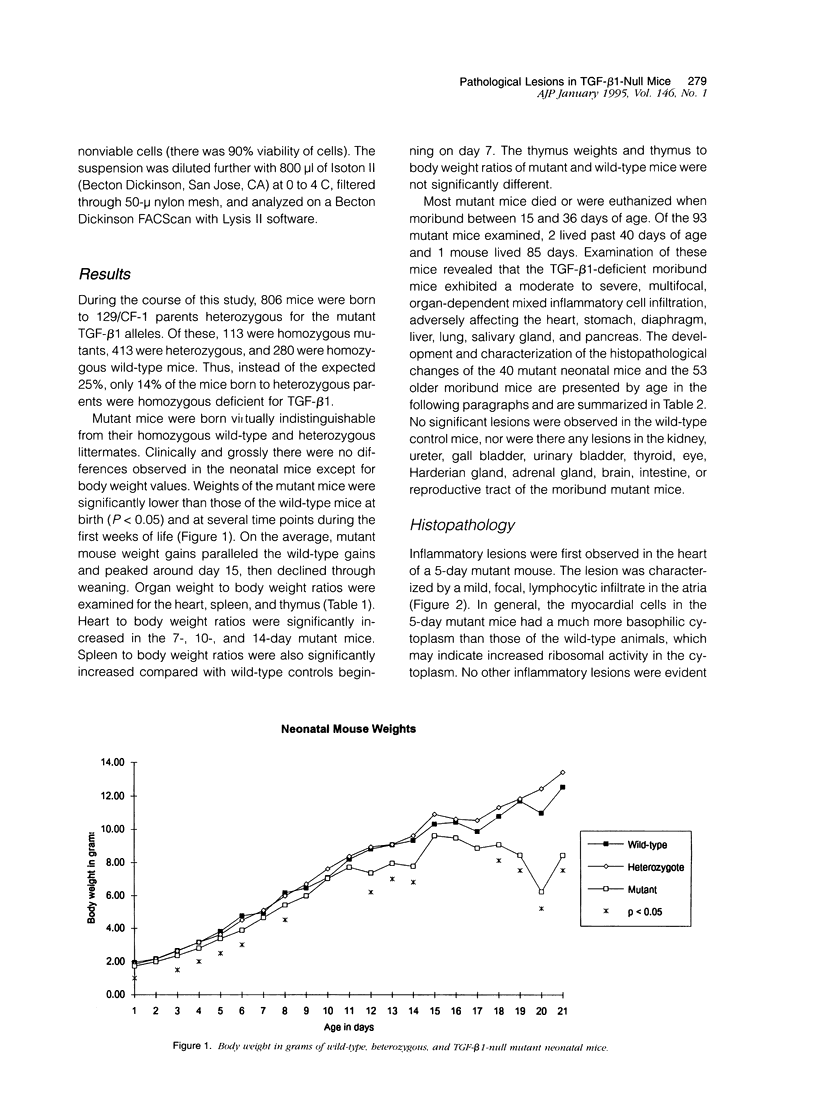
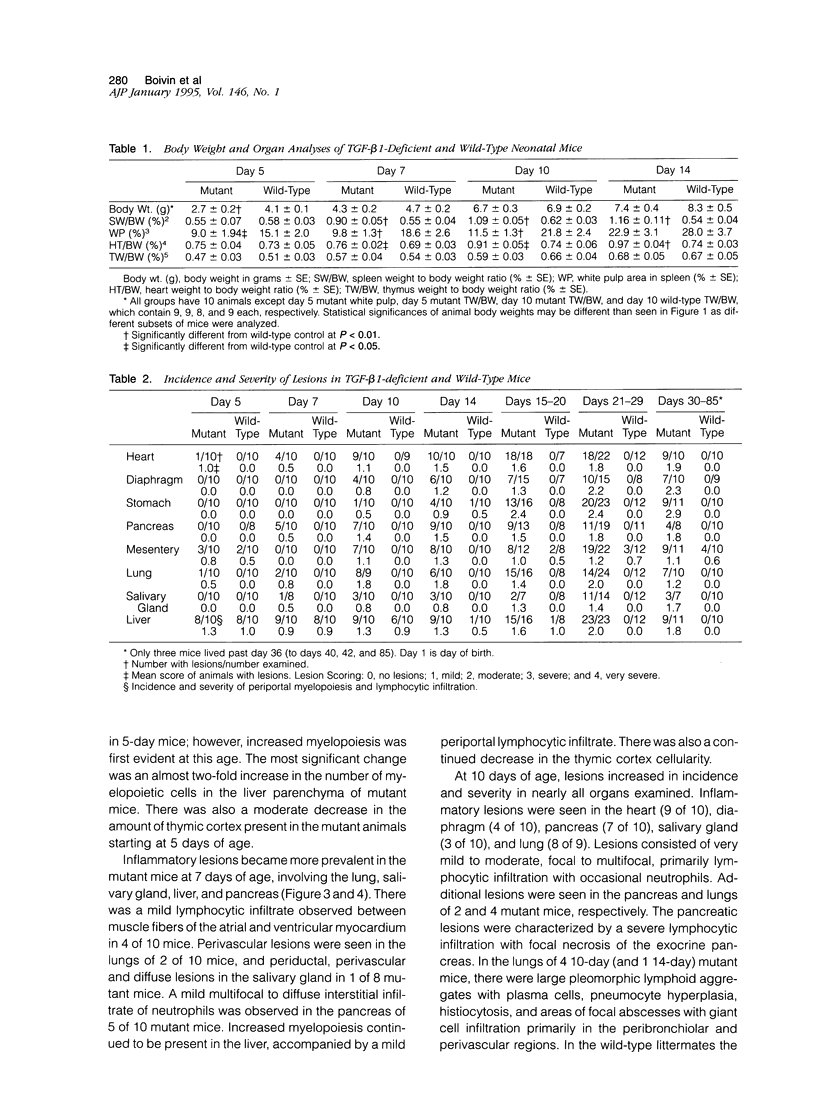
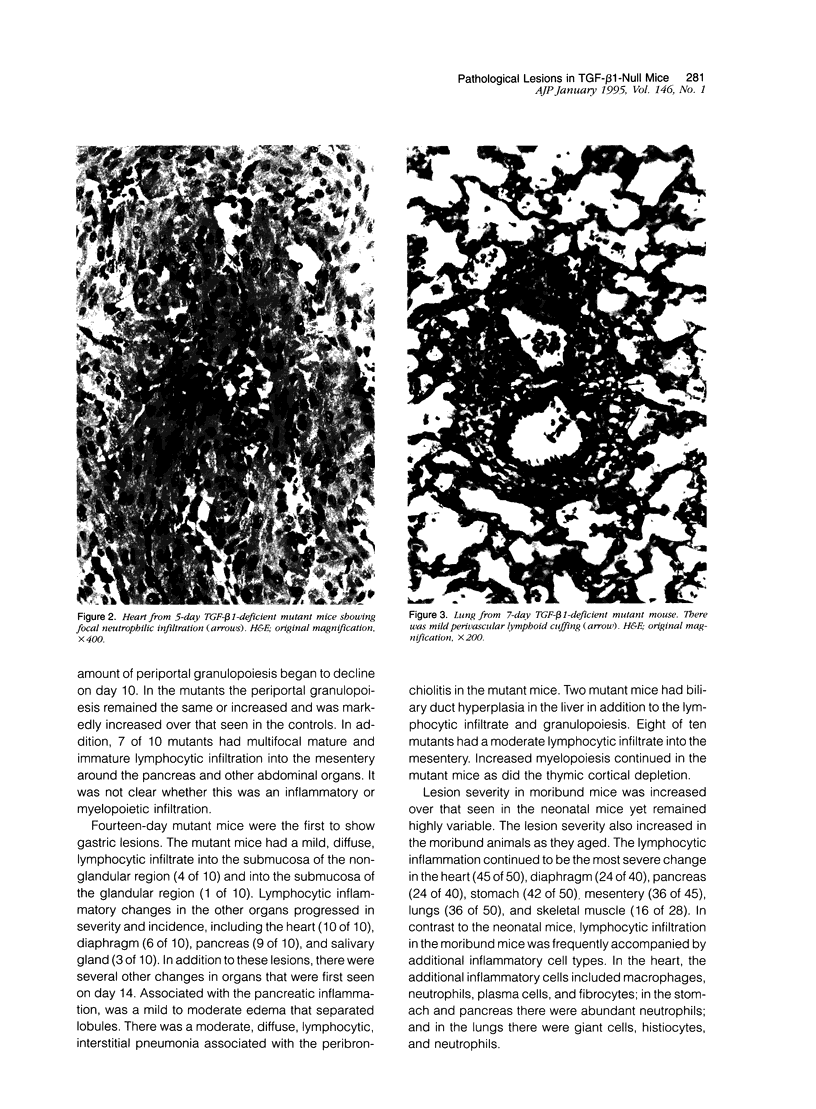
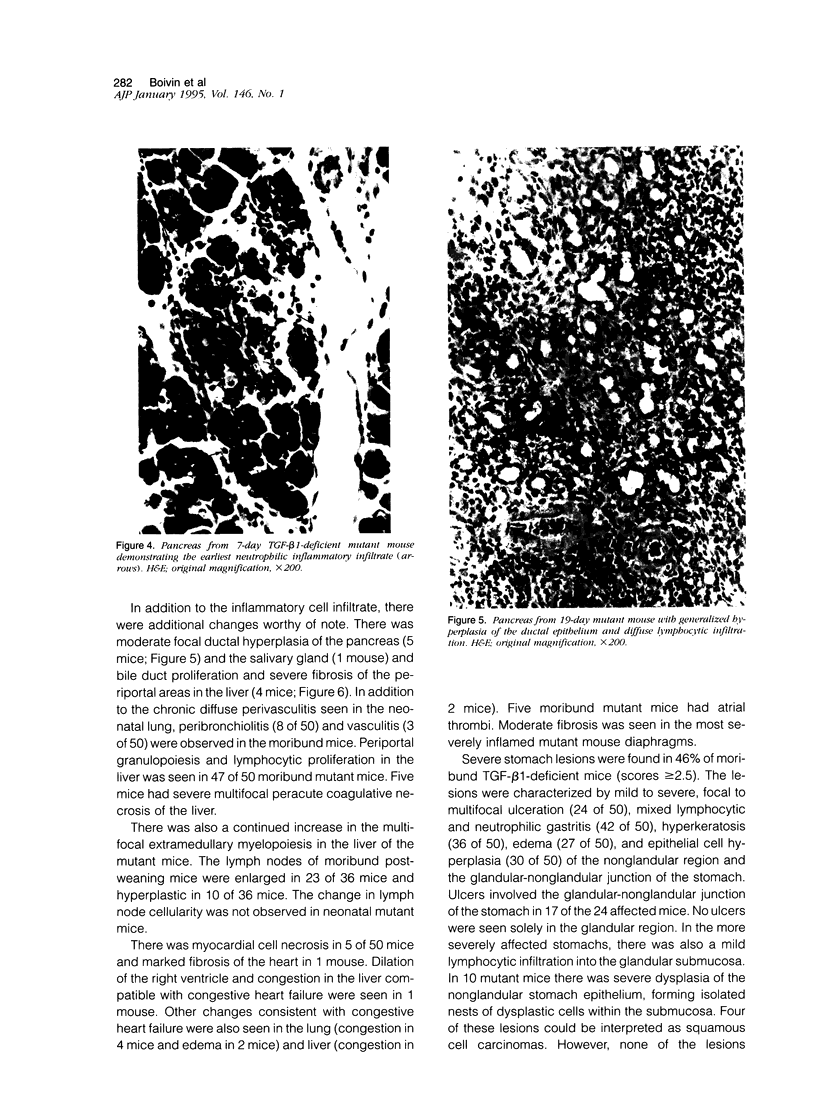
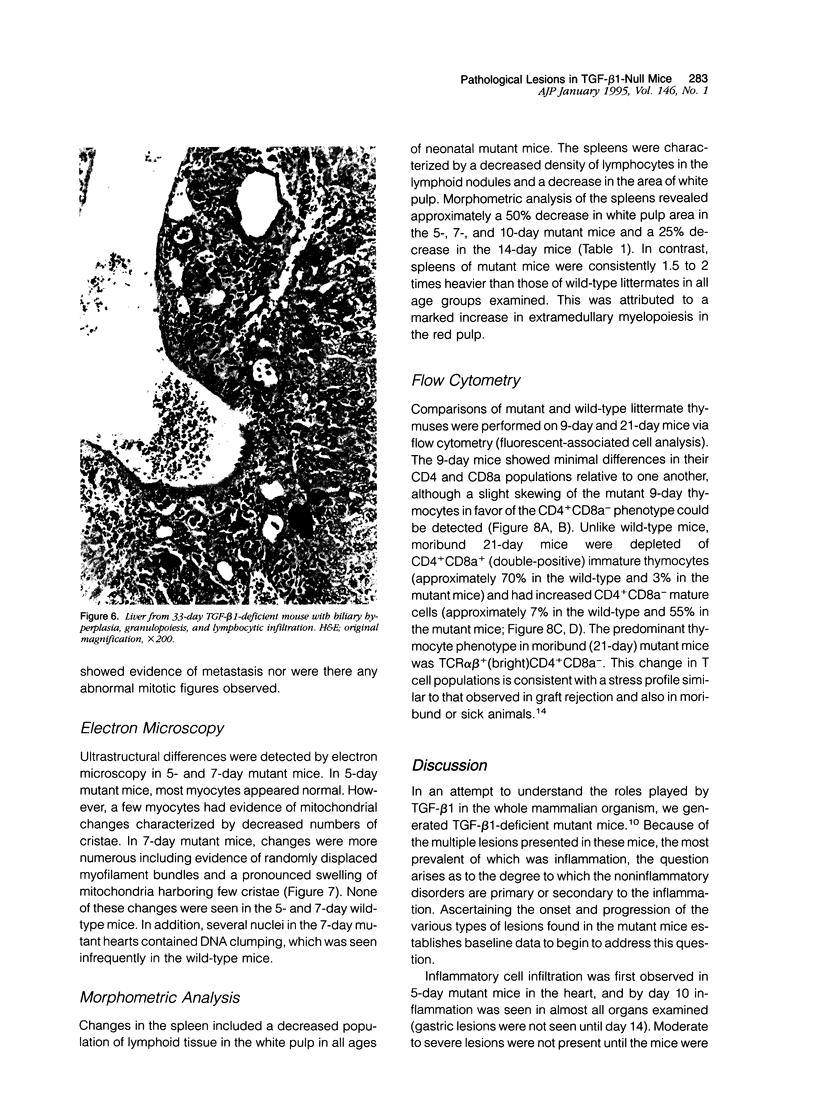
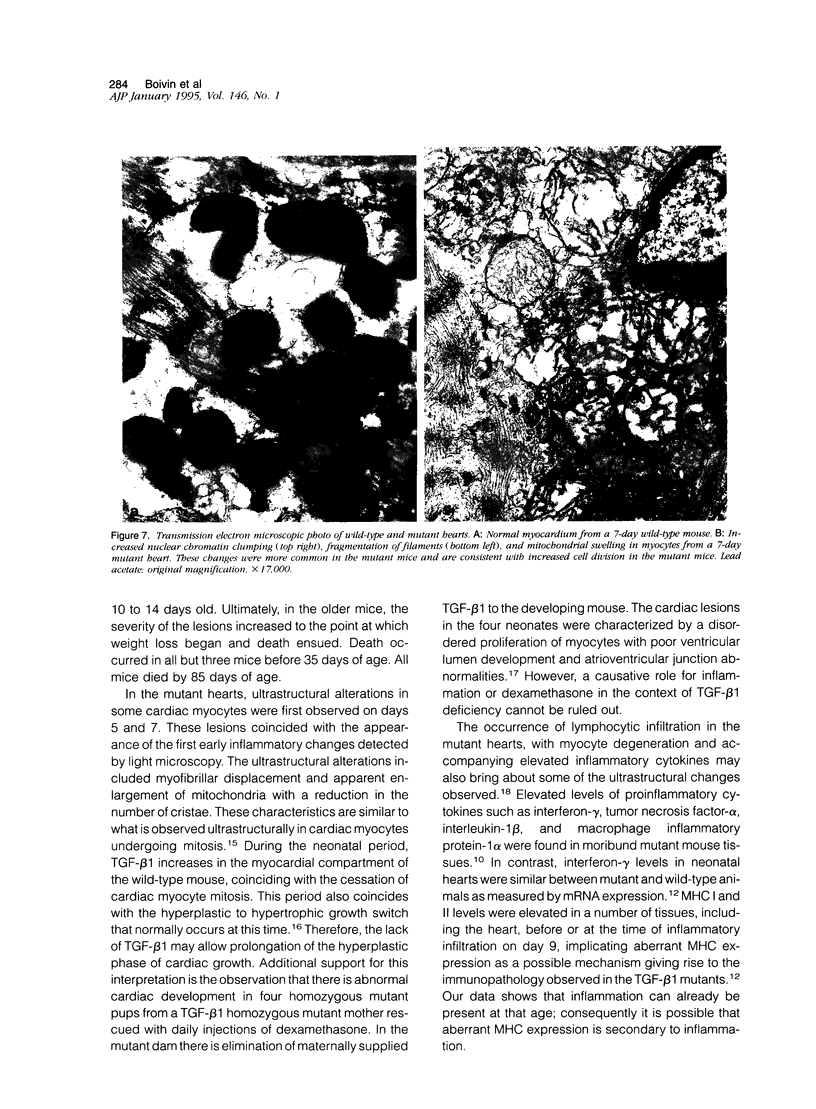
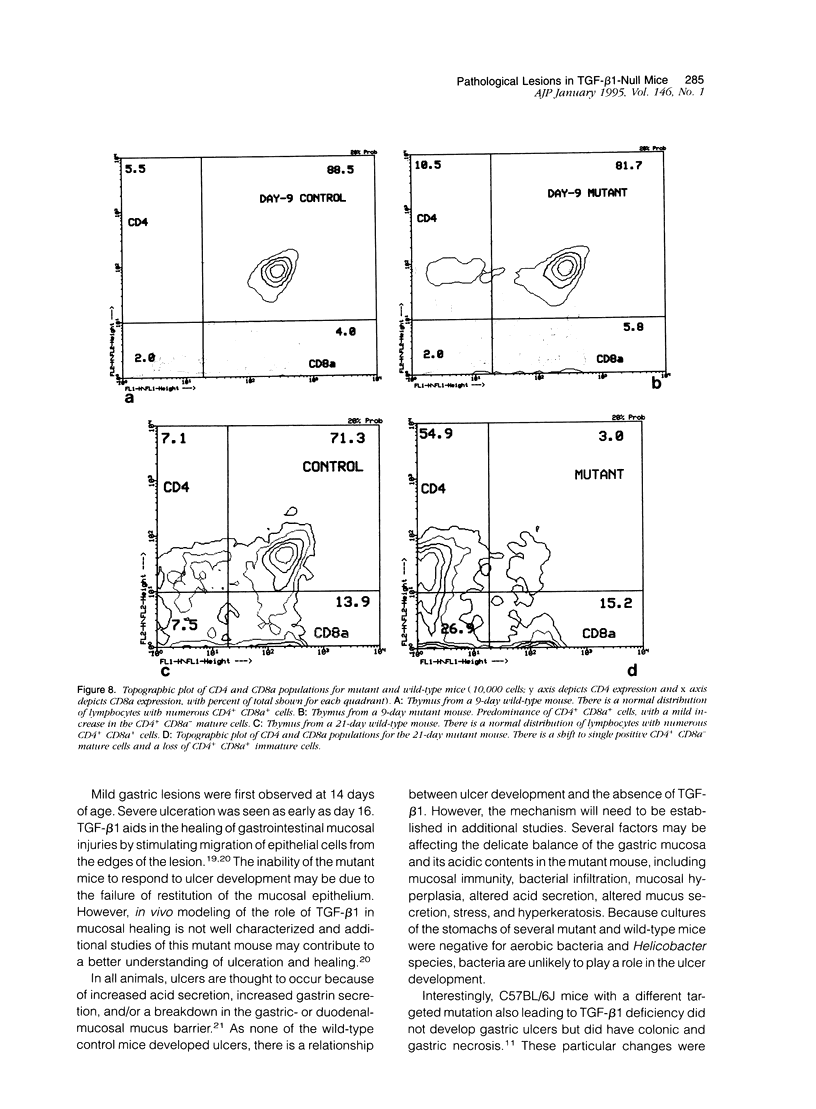
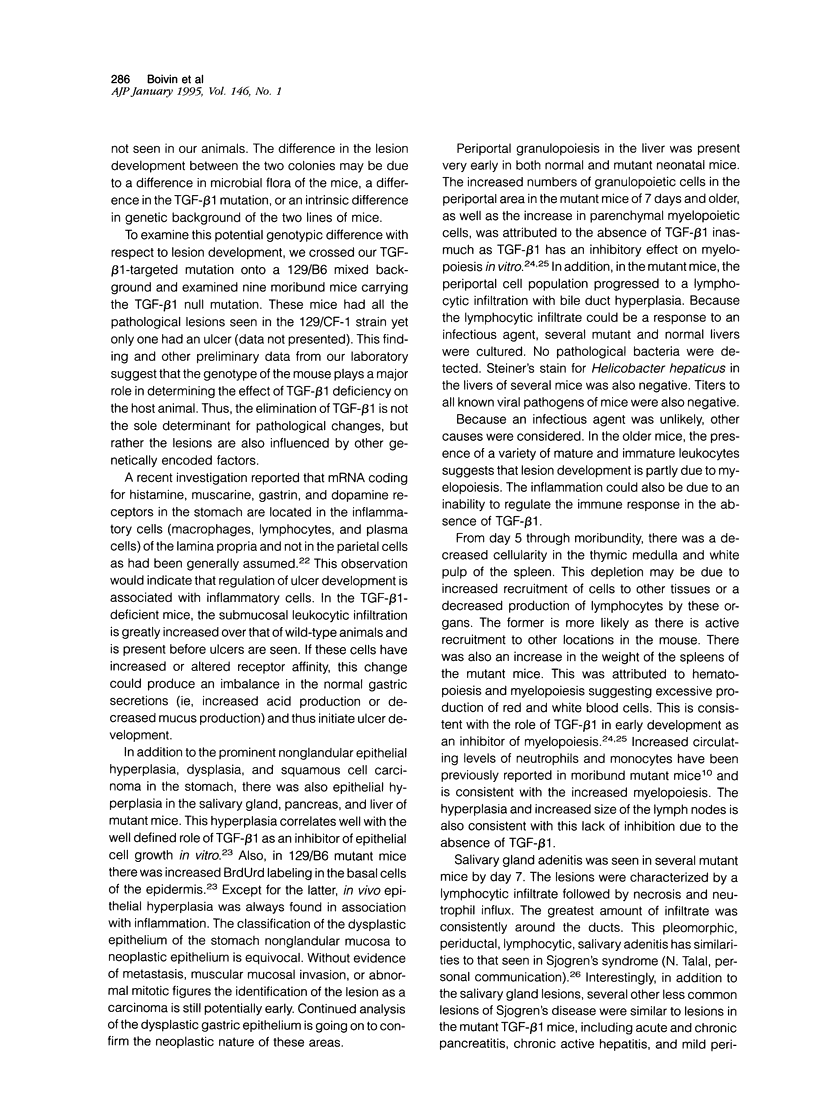
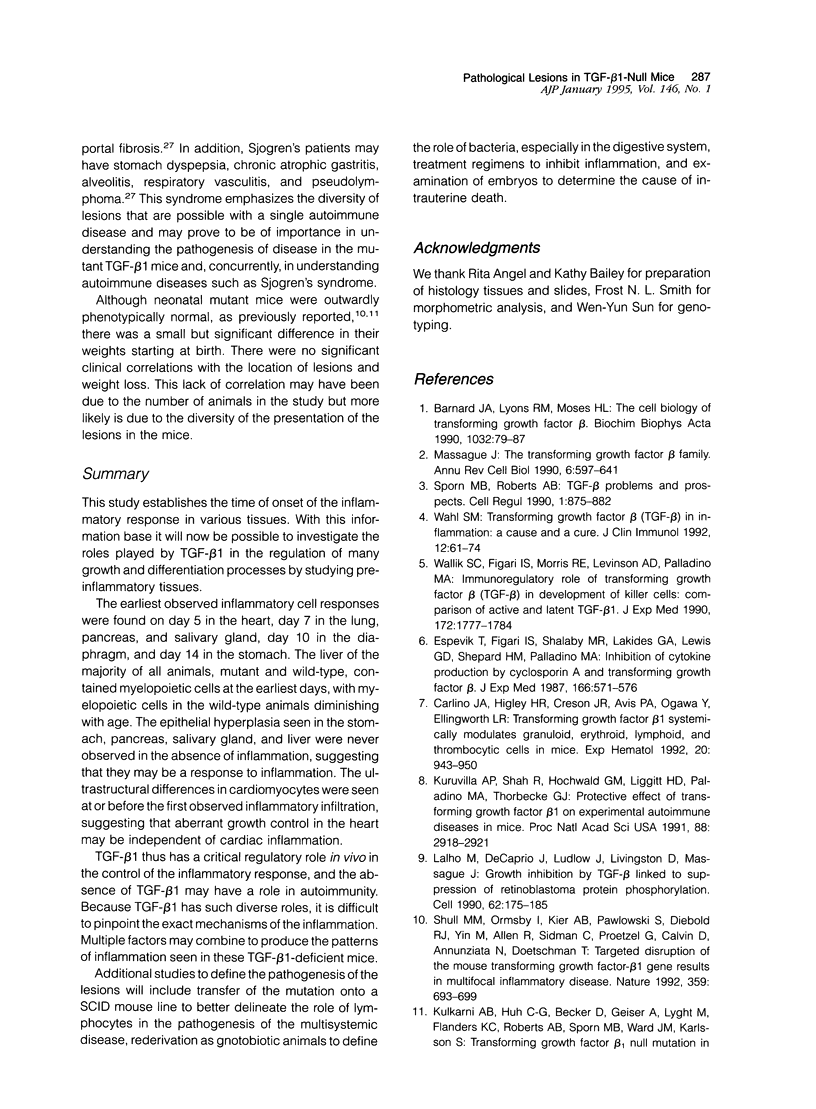
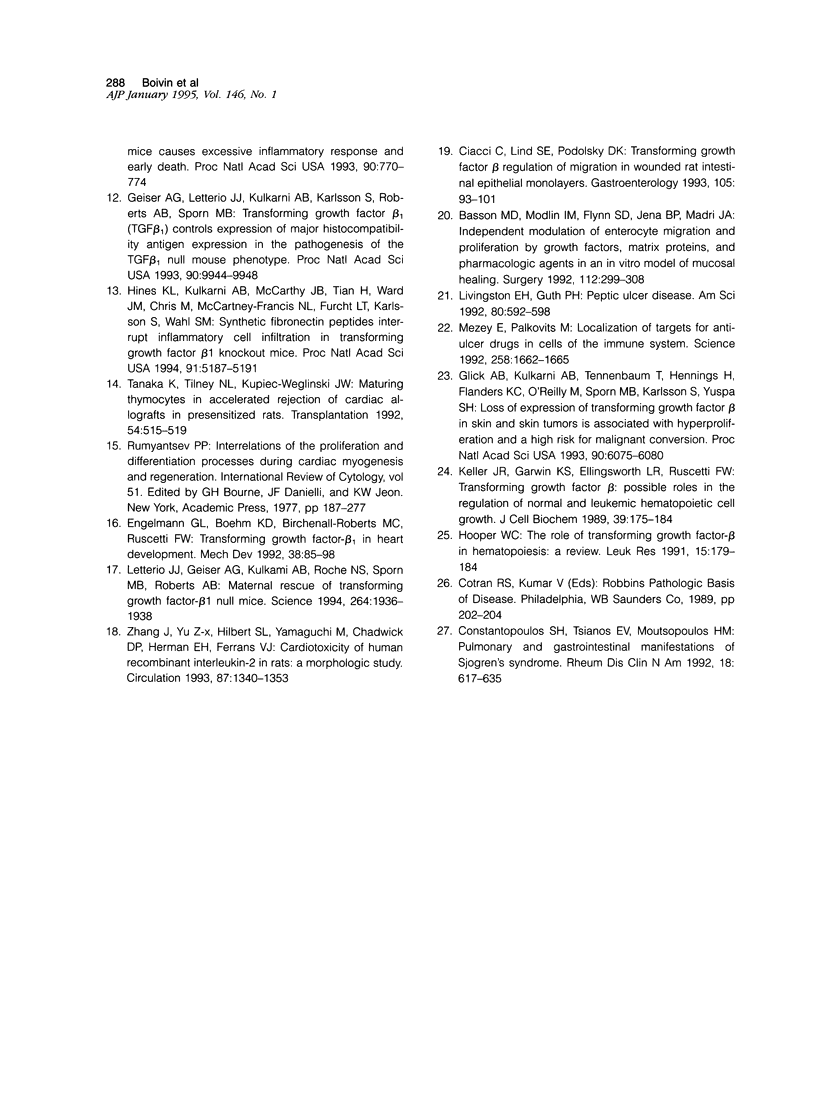
Images in this article
Selected References
These references are in PubMed. This may not be the complete list of references from this article.
- Barnard J. A., Lyons R. M., Moses H. L. The cell biology of transforming growth factor beta. Biochim Biophys Acta. 1990 Jun 1;1032(1):79–87. doi: 10.1016/0304-419x(90)90013-q. [DOI] [PubMed] [Google Scholar]
- Basson M. D., Modlin I. M., Flynn S. D., Jena B. P., Madri J. A. Independent modulation of enterocyte migration and proliferation by growth factors, matrix proteins, and pharmacologic agents in an in vitro model of mucosal healing. Surgery. 1992 Aug;112(2):299–308. [PubMed] [Google Scholar]
- Carlino J. A., Higley H. R., Creson J. R., Avis P. D., Ogawa Y., Ellingsworth L. R. Transforming growth factor beta 1 systemically modulates granuloid, erythroid, lymphoid, and thrombocytic cells in mice. Exp Hematol. 1992 Sep;20(8):943–950. [PubMed] [Google Scholar]
- Ciacci C., Lind S. E., Podolsky D. K. Transforming growth factor beta regulation of migration in wounded rat intestinal epithelial monolayers. Gastroenterology. 1993 Jul;105(1):93–101. doi: 10.1016/0016-5085(93)90014-4. [DOI] [PubMed] [Google Scholar]
- Constantopoulos S. H., Tsianos E. V., Moutsopoulos H. M. Pulmonary and gastrointestinal manifestations of Sjögren's syndrome. Rheum Dis Clin North Am. 1992 Aug;18(3):617–635. [PubMed] [Google Scholar]
- Engelmann G. L., Boehm K. D., Birchenall-Roberts M. C., Ruscetti F. W. Transforming growth factor-beta 1 in heart development. Mech Dev. 1992 Aug;38(2):85–97. doi: 10.1016/0925-4773(92)90001-z. [DOI] [PubMed] [Google Scholar]
- Espevik T., Figari I. S., Shalaby M. R., Lackides G. A., Lewis G. D., Shepard H. M., Palladino M. A., Jr Inhibition of cytokine production by cyclosporin A and transforming growth factor beta. J Exp Med. 1987 Aug 1;166(2):571–576. doi: 10.1084/jem.166.2.571. [DOI] [PMC free article] [PubMed] [Google Scholar]
- Geiser A. G., Letterio J. J., Kulkarni A. B., Karlsson S., Roberts A. B., Sporn M. B. Transforming growth factor beta 1 (TGF-beta 1) controls expression of major histocompatibility genes in the postnatal mouse: aberrant histocompatibility antigen expression in the pathogenesis of the TGF-beta 1 null mouse phenotype. Proc Natl Acad Sci U S A. 1993 Nov 1;90(21):9944–9948. doi: 10.1073/pnas.90.21.9944. [DOI] [PMC free article] [PubMed] [Google Scholar]
- Glick A. B., Kulkarni A. B., Tennenbaum T., Hennings H., Flanders K. C., O'Reilly M., Sporn M. B., Karlsson S., Yuspa S. H. Loss of expression of transforming growth factor beta in skin and skin tumors is associated with hyperproliferation and a high risk for malignant conversion. Proc Natl Acad Sci U S A. 1993 Jul 1;90(13):6076–6080. doi: 10.1073/pnas.90.13.6076. [DOI] [PMC free article] [PubMed] [Google Scholar]
- Hines K. L., Kulkarni A. B., McCarthy J. B., Tian H., Ward J. M., Christ M., McCartney-Francis N. L., Furcht L. T., Karlsson S., Wahl S. M. Synthetic fibronectin peptides interrupt inflammatory cell infiltration in transforming growth factor beta 1 knockout mice. Proc Natl Acad Sci U S A. 1994 May 24;91(11):5187–5191. doi: 10.1073/pnas.91.11.5187. [DOI] [PMC free article] [PubMed] [Google Scholar]
- Hooper W. C. The role of transforming growth factor-beta in hematopoiesis. A review. Leuk Res. 1991;15(4):179–184. doi: 10.1016/0145-2126(91)90118-d. [DOI] [PubMed] [Google Scholar]
- Keller J. R., Sing G. K., Ellingsworth L. R., Ruscetti F. W. Transforming growth factor beta: possible roles in the regulation of normal and leukemic hematopoietic cell growth. J Cell Biochem. 1989 Feb;39(2):175–184. doi: 10.1002/jcb.240390209. [DOI] [PubMed] [Google Scholar]
- Kuruvilla A. P., Shah R., Hochwald G. M., Liggitt H. D., Palladino M. A., Thorbecke G. J. Protective effect of transforming growth factor beta 1 on experimental autoimmune diseases in mice. Proc Natl Acad Sci U S A. 1991 Apr 1;88(7):2918–2921. doi: 10.1073/pnas.88.7.2918. [DOI] [PMC free article] [PubMed] [Google Scholar]
- Laiho M., DeCaprio J. A., Ludlow J. W., Livingston D. M., Massagué J. Growth inhibition by TGF-beta linked to suppression of retinoblastoma protein phosphorylation. Cell. 1990 Jul 13;62(1):175–185. doi: 10.1016/0092-8674(90)90251-9. [DOI] [PubMed] [Google Scholar]
- Letterio J. J., Geiser A. G., Kulkarni A. B., Roche N. S., Sporn M. B., Roberts A. B. Maternal rescue of transforming growth factor-beta 1 null mice. Science. 1994 Jun 24;264(5167):1936–1938. doi: 10.1126/science.8009224. [DOI] [PubMed] [Google Scholar]
- Massagué J. The transforming growth factor-beta family. Annu Rev Cell Biol. 1990;6:597–641. doi: 10.1146/annurev.cb.06.110190.003121. [DOI] [PubMed] [Google Scholar]
- Mezey E., Palkovits M. Localization of targets for anti-ulcer drugs in cells of the immune system. Science. 1992 Dec 4;258(5088):1662–1665. doi: 10.1126/science.1333642. [DOI] [PubMed] [Google Scholar]
- Shull M. M., Ormsby I., Kier A. B., Pawlowski S., Diebold R. J., Yin M., Allen R., Sidman C., Proetzel G., Calvin D. Targeted disruption of the mouse transforming growth factor-beta 1 gene results in multifocal inflammatory disease. Nature. 1992 Oct 22;359(6397):693–699. doi: 10.1038/359693a0. [DOI] [PMC free article] [PubMed] [Google Scholar]
- Sporn M. B., Roberts A. B. TGF-beta: problems and prospects. Cell Regul. 1990 Nov;1(12):875–882. doi: 10.1091/mbc.1.12.875. [DOI] [PMC free article] [PubMed] [Google Scholar]
- Tanaka K., Tilney N. L., Kupiec-Weglinski J. W. Maturing thymocytes in accelerated rejection of cardiac allografts in presensitized rats. Transplantation. 1992 Sep;54(3):515–519. doi: 10.1097/00007890-199209000-00024. [DOI] [PubMed] [Google Scholar]
- Wahl S. M. Transforming growth factor beta (TGF-beta) in inflammation: a cause and a cure. J Clin Immunol. 1992 Mar;12(2):61–74. doi: 10.1007/BF00918135. [DOI] [PubMed] [Google Scholar]
- Wallick S. C., Figari I. S., Morris R. E., Levinson A. D., Palladino M. A. Immunoregulatory role of transforming growth factor beta (TGF-beta) in development of killer cells: comparison of active and latent TGF-beta 1. J Exp Med. 1990 Dec 1;172(6):1777–1784. doi: 10.1084/jem.172.6.1777. [DOI] [PMC free article] [PubMed] [Google Scholar]
- Zhang J., Yu Z. X., Hilbert S. L., Yamaguchi M., Chadwick D. P., Herman E. H., Ferrans V. J. Cardiotoxicity of human recombinant interleukin-2 in rats. A morphological study. Circulation. 1993 Apr;87(4):1340–1353. doi: 10.1161/01.cir.87.4.1340. [DOI] [PubMed] [Google Scholar]



